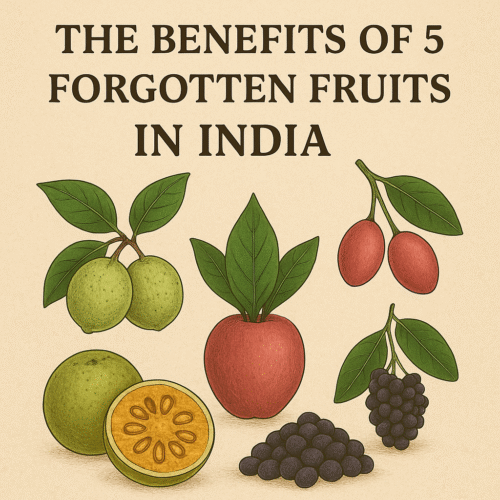Introduction
Forgotten fruits in India are making a powerful comeback—and for good reason. These ancient, nutrient-rich treasures are more than just relics of our food heritage; they are nature’s answer to modern health and environmental challenges. Packed with antioxidants, fiber, vitamins, and medicinal properties, these underappreciated fruits offer immense benefits for healthy living, including gut health, immunity, weight management, mental clarity, and sustainable farming practices.
Despite being once cherished in Indian households and Ayurvedic medicine, fruits like Bael, Phalsa, Khirni, Chalta, and Karonda have faded into obscurity due to commercialization and changing food preferences. But in an era where clean eating, sustainability, and functional nutrition matter more than ever, it’s time to rediscover the benefits of forgotten fruits in India.
This comprehensive guide explores their incredible health advantages, cultural significance, environmental impact, and how you can reintroduce them into your diet and lifestyle. Whether you’re aiming to boost your immunity, lose weight naturally, or support local farming, these fruits are your untapped super-foods.
Why Forgotten Fruits in India Deserve a Comeback
Our forgotten fruits in India are resilient, diverse and environmentally sustainable, making them ideal for healthy living and ecosystem health. Cultivating these native fruits supports biodiversity, conserves water, and offers nutritious produce. Highlighting 5 forgotten fruits from India showcases both wellness and planetary benefits.
Bael (Wood Apple)
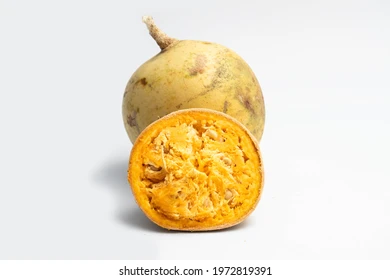
Bael, or Wood Apple, thrives in arid zones with minimal irrigation, enhancing soil stability in degraded landscapes. Nutritionally, it aids digestion and boosts immunity with its rich content of antioxidants and fiber. In Ayurveda, it’s traditionally used to soothe stomach disorders. Being drought-resistant, bael is ideal for sustainable orchards in semi-dry Indian regions.
Health Benefits of Bael
1. Promotes Gut Health
Bael is a natural remedy for digestive disorders:
- Its pulp contains tannins and mucilage, which reduce inflammation and soothe the intestinal lining.
- It is highly effective in treating constipation, diarrhea, IBS, colitis, and dysentery.
- The pectin fiber in bael acts as a prebiotic, supporting the growth of beneficial gut bacteria.
2. Strengthens Immunity
Bael fruit is rich in vitamin C, beta-carotene, and flavonoids, all of which:
- Enhance immune response
- Reduce oxidative stress
- Support the body in fighting infections and chronic inflammation
3. Balances Blood Sugar and Cholesterol
Due to its low glycemic index and fiber content:
- Bael helps regulate blood glucose levels, making it suitable for people with diabetes.
- Its bioactive compounds lower bad cholesterol (LDL) and increase good cholesterol (HDL).
4. Detoxifies the Body
Bael works as a natural detoxifier by
- Supporting liver function
- Flushing out toxins through the digestive tract
- Aiding the elimination of excess heat and inflammation, particularly beneficial during hot seasons
5. Calms the Nervous System
In Ayurveda, bael is believed to have Vata-pacifying properties, making it:
- Helpful for reducing stress, anxiety, and restlessness
- A natural remedy for mental fatigue and sleep disturbances
How to Consume Bael
- Juice: Fresh bael pulp blended with water, a bit of jaggery, and lemon—perfect for summer detox.
- Pulp: Eaten raw or mixed with spices for digestion.
- Powdered: Dried bael pulp is used in teas, herbal mixes, and Ayurvedic supplements.
- Bael candy: Made from dried slices soaked in honey—an immunity-boosting treat.
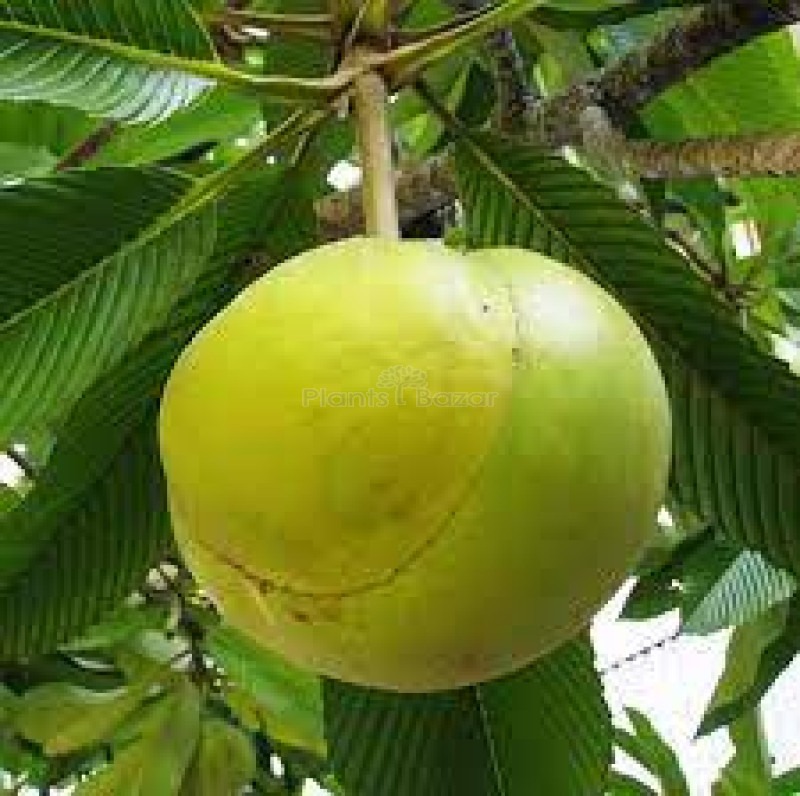
Chalta (Elephant Apple)
Chalta, or Elephant Apple,(Dillenia indica), is a native Indian fruit found mostly in the eastern and northeastern regions of India. Often overlooked today, chalta is a nutritional powerhouse . From liver detoxification to heart health support, this fruit carries remarkable healing properties that align beautifully with both wellness and sustainability.
Health Benefits of Chalta (Elephant Apple)
1. Supports Liver Detoxification
- Chalta is rich in polyphenols, flavonoids, and vitamin C, which help neutralize toxins and protect liver tissues.
- Its antioxidant activity reduces oxidative stress in the liver, supporting the natural detoxification process.
- Traditionally used in Ayurvedic preparations to flush out excess bile and heat from the body.
2. Boosts Heart Health
- Contains potassium, magnesium, and dietary fiber, which help:
- Regulate blood pressure
- Lower LDL cholesterol
- Improve circulation and vascular elasticity
- Its anti-inflammatory compounds reduce arterial inflammation and prevent the buildup of plaques, thus lowering the risk of heart disease.
3. Improves Digestion and Gut Function
- The fruit’s natural acidity and fiber stimulate digestive enzymes, making it excellent for stimulating appetite and easing indigestion.
- Acts as a mild laxative, promoting regular bowel movements and reducing bloating.
4. Strengthens Immunity
- Rich in vitamin C and antioxidants, Chalta boosts the immune system by increasing white blood cell activity and defending against seasonal infections.
5. Aids Weight Management
- Being low in calories and high in fiber, it offers satiety without adding excessive calories.
- Its sour taste helps curb cravings and refreshes the palate naturally.
Phalsa (Indian Sherbet Berry)
Phalsa is a small berry valued for its cooling effect, anti-inflammatory compounds, and refreshing flavor. Ecologically, its flowers support bees and local pollinators during late spring. Its use in syrups and juices promotes hydration—a natural alternative to sugary drinks, reducing plastic bottle dependency.
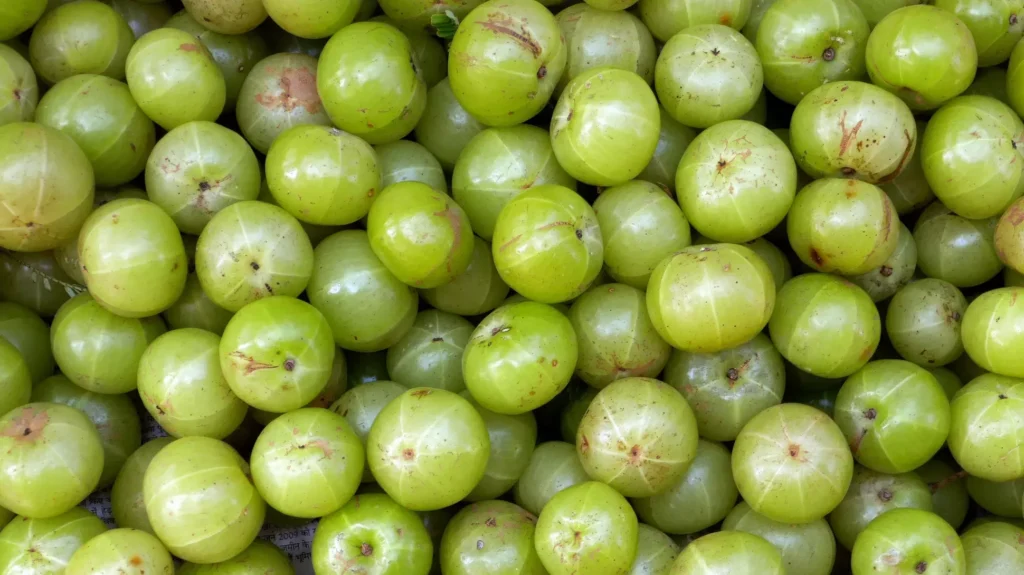
Health Benefits of Phalsa
1. Natural Body Coolant
- Phalsa is highly effective in regulating body temperature during hot seasons.
- Its juice helps reduce internal heat and prevents heatstroke, dehydration, and excessive thirst.
- Often used in summer sherbets and cooling tonics to soothe the body and refresh the senses.
2. Powerful Anti-inflammatory Agent
- Rich in anthocyanins, flavonoids, and polyphenols, Phalsa helps reduce:
- Joint inflammation
- Muscle soreness
- Inflammatory bowel conditions
- Regular intake has shown benefits in managing arthritis, acidity, and skin rashes linked to excess Pitta.
3. Digestive Support
- The fruit contains natural enzymes and moderate fiber that support digestion.
- It acts as a mild laxative, reduces bloating, and helps soothe indigestion or acidity after meals.
4. Promotes Heart and Liver Health
- Its antioxidants protect the heart from oxidative stress and inflammation.
- Phalsa supports healthy blood circulation, helps reduce bad cholesterol (LDL), and aids liver detoxification.
5. Boosts Immunity and Fights Infections
- Packed with vitamin C, Phalsa helps increase white blood cell count and supports the immune system.
- Its antibacterial and antiviral compounds have been used in folk medicine to treat colds, coughs, and urinary tract infections.
Khirni (Rayan)
Khirni (Rayan) or Manilkara hexandra, is a small, sweet, golden-yellow fruit native to the Indian subcontinent. Once a common sight in rural backyards and forest fringes, Khirni has been largely overlooked in modern diets. However, its nutritional richness, beauty-enhancing properties, and climate resilience make it one of the most valuable forgotten fruits in India.
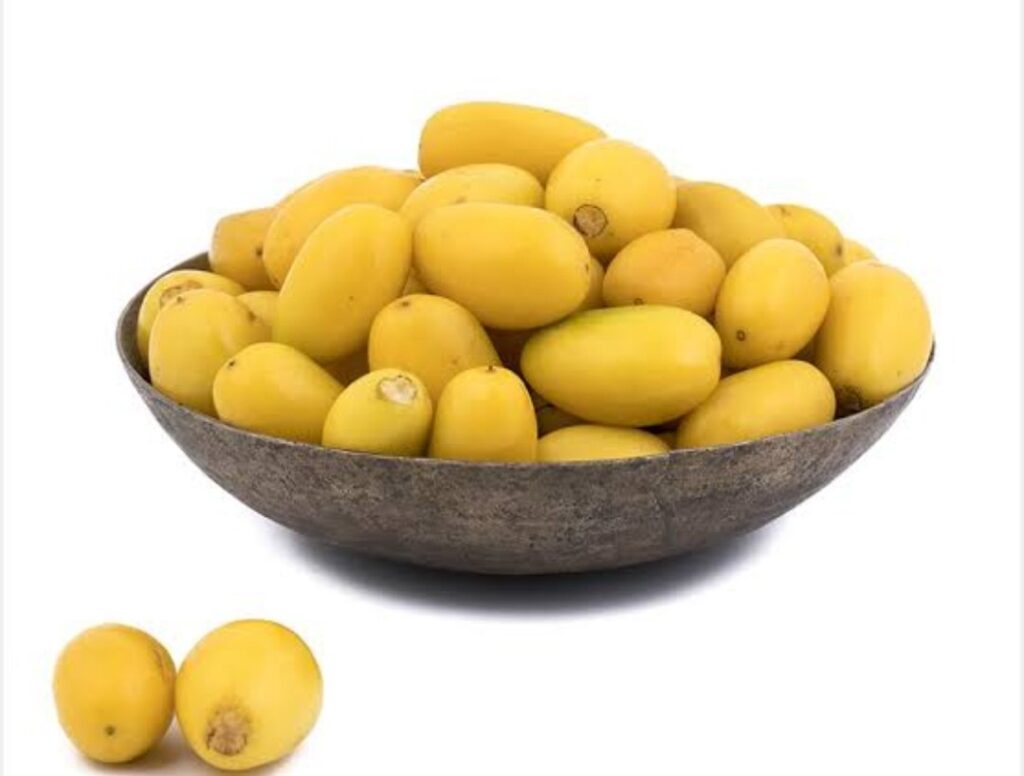
Health Benefits of Khirni (Rayan)
1. Enhances Skin Glow and Hair Health
Khirni is packed with vitamin A, beta-carotene, and antioxidants, which are essential for:
- Maintaining youthful skin by reducing oxidative damage
- Improving skin texture and elasticity
- Promoting natural glow from within
- Reducing acne and pigmentation
Its hydrating sugars and micro-nutrients help improve blood circulation, giving the skin a fresh, radiant appearance.
2. Boosts Natural Energy and Vitality
Khirni is a natural energy booster, thanks to its:
- High natural sugar content (fructose and glucose), which provides quick and sustained energy
- B-complex vitamins that help convert food into fuel
- Iron and magnesium that improve stamina, oxygen flow, and reduce fatigue
Ideal for athletes, students, or anyone feeling low on energy, khirni offers a clean, non-caffeinated energy lift.
3. Improves Digestion and Gut Health
- Rich in dietary fiber, Khirni helps maintain bowel regularity and prevents constipation.
- Its soothing nature supports gut flora, and its natural enzymes assist in nutrient absorption.
- Recommended in traditional remedies to improve appetite and soothe digestive discomfort.
4. Supports Blood Health and Immunity
Khirni contains iron, vitamin C, and copper, which support:
- Red blood cell formation
- Iron absorption and circulation
- Immunity boost by enhancing immune cell function
This makes it particularly beneficial for anemia-prone individuals, especially women and children.
5. Helps Regulate Blood Sugar (In Moderation)
Despite its sweet taste, Khirni has a moderate glycemic index, and its fiber content helps:
- Slow down sugar absorption
- Improve insulin sensitivity
- Prevent post-meal sugar spikes
When consumed in moderation, it’s suitable for people managing blood sugar levels naturally.
Read:Navalpazham (Black Plum): Health Benefits, Uses & More | The Purple Powerhouse
6. Excellent for Children and the Elderly
Due to its soft texture, natural sweetness, and digestibility, Khirni is:
- Ideal for growing children as a nutrient-dense snack
- Suitable for the elderly, offering energy without putting stress on digestion
Its high calcium and phosphorus content also supports bone strength and muscle health.
Karonda (Natal Plum)
Karonda (Natal Plum) is packed with iron, vitamins, and antioxidants, helping combat anemia and fortify immunity. As a native shrub, it thrives in marginal soils and supports local biodiversity. Its deep roots prevent erosion, while berries are perfect for pickles or preserves—enhancing nutrition and food security in rural communities.
Health Benefits of Karonda (Natal Plum)
Karonda, also known as Natal Plum (Carissa carandas), is a small, tart fruit native to India and parts of Southeast Asia. Traditionally used in pickles, chutneys, and medicinal tonics, this forgotten fruit is now being rediscovered for its exceptional nutritional profile and ecological benefits. Rich in iron, antioxidants, and phytochemicals, Karonda is a potent tool for boosting immunity, fighting anemia, and enhancing biodiversity in rural ecosystems.
1. Iron-Rich and Anemia-Fighting Properties
- Karonda is one of the rare fruits naturally high in iron, making it ideal for:
- Treating and preventing iron-deficiency anemia
- Supporting hemoglobin production
- Improving oxygen transport and energy levels, especially in women and adolescents
Its iron is easily absorbed due to the presence of vitamin C, making it a powerful fruit for people with low iron stores.
2. Boosts Immune System Naturally
- Karonda is packed with vitamin C, flavonoids, and polyphenols, which:
- Strengthen the immune response
- Neutralize free radicals
- Speed up recovery from colds, flu, and infections
It also enhances white blood cell activity, giving the body a stronger defense against microbial invasions.
3. Supports Digestive and Cardiovascular Health
- Rich in fiber, Karonda promotes:
- Healthy digestion
- Bowel regularity
- Gut detoxification
It also supports heart health by:
- Reducing bad cholesterol (LDL)
- Improving blood circulation
- Preventing arterial damage through antioxidant protection
4. Helps in Blood Sugar Regulation
- Karonda has a low glycemic index, making it a suitable fruit for people managing diabetes.
- Its natural compounds assist in insulin sensitivity and blood sugar control when consumed in moderation.
5. Antimicrobial and Anti-inflammatory Effects
- Karonda’s bioactive compounds exhibit antibacterial, antifungal, and anti-inflammatory properties.
- It is traditionally used to treat:
- Mouth ulcers
- Infections
- Skin irritations
Its astringent nature also helps in wound healing and preventing microbial growth.
6. Excellent for Skin, Hair, and Bone Health
- Vitamin C and calcium in Karonda:
- Stimulate collagen production
- Improve bone density
- Strengthen hair roots and reduce hair fall
Its antioxidant content delays skin aging and reduces blemishes and oxidative damage.
7. Enhances Mental Clarity and Reduces Fatigue
- The iron-magnesium combo improves:
- Oxygen supply to the brain
- Mental alertness and concentration
- Reduces stress-related fatigue and dizziness
Great for students, working professionals, and those with brain fog or tiredness.
8. Biodiversity and Ecological Support
- Karonda grows well in semi-arid, low-water regions and is often planted as a living fence.
- It supports:
- Local wildlife like birds and pollinators
- Soil stabilization with its strong root system
- Natural pest resistance, reducing the need for chemical inputs
Nutritional Value of Forgotten Indian Fruits (per 100g)
| Nutrient | Bael (Wood Apple) | Phalsa (Sherbet Berry) | Khirni (Rayan) | Chalta (Elephant Apple) | Karonda (Natal Plum) |
|---|---|---|---|---|---|
| Calories | 137 kcal | 45 kcal | 60 kcal | 52 kcal | 60 kcal |
| Carbohydrates | 31 g | 10 g | 13 g | 11 g | 14 g |
| Protein | 1.8 g | 0.9 g | 1.2 g | 1.0 g | 1.1 g |
| Fat | 0.4 g | 0.2 g | 0.5 g | 0.3 g | 0.4 g |
| Fiber | 2.9 g | 1.5 g | 3.0 g | 2.0 g | 2.5 g |
| Vitamin C | 8 mg | 22 mg | 15 mg | 12 mg | 20 mg |
| Calcium | 85 mg | 129 mg | 78 mg | 90 mg | 45 mg |
| Iron | 0.7 mg | 1.0 mg | 2.0 mg | 0.8 mg | 2.5 mg |
| Potassium | 600 mg | 120 mg | 190 mg | 200 mg | 180 mg |
| Magnesium | 30 mg (approx.) | 20 mg (approx.) | 25 mg (approx.) | 30 mg | 28 mg |
| Beta-Carotene | 55 mcg | Moderate | High | Low | Moderate |
| Anthocyanins | Low | High | Low | Low | Moderate |
Note: These values are estimates based on published agricultural and nutritional sources. Actual content may vary depending on soil quality, fruit ripeness, and growing conditions.
Conclusion
Bringing back the forgotten fruits in India is more than just reviving flavors of the past—it’s about embracing a holistic approach to nutrition, sustainability, and cultural wellness. From boosting immunity and aiding weight loss to improving mental health and supporting the environment, these fruits hold the potential to transform how we eat and live.
As we face the challenges of climate change, rising lifestyle diseases, and loss of biodiversity, turning to our own indigenous fruits is not just practical—it’s essential. Whether you enjoy them as refreshing drinks, wholesome meals, or natural remedies, integrating these fruits into your daily life honors both your health and the heritage of the land.
So next time you’re at the market or tending to your garden, think local, think seasonal, and think sustainable. Reconnect with the forgotten fruits of India, and unlock a vibrant path to healthy living—one bite at a time.
Frequently Asked Questions (FAQs)
About the Benefits of Forgotten Fruits in India for Healthy Living
What are forgotten fruits in India?
Forgotten fruits in India are indigenous or traditional fruits that were once widely consumed but have become rare in modern diets. Examples include Bael, Phalsa, Khirni, Chalta, and Karonda. These fruits are known for their medicinal, nutritional, and ecological benefits.
Are forgotten fruits really beneficial for health?
Yes, these fruits are rich in fiber, antioxidants, vitamins, and minerals, which support immunity, digestion, mental clarity, weight loss, and overall well-being. Their low glycemic index and natural nutrient profile make them ideal for daily consumption.
Can children and elderly safely consume these fruits?
Absolutely. Forgotten fruits are gentle on the digestive system and can be consumed by both kids and elderly individuals. However, it’s best to serve them in suitable forms—like juices, purees, or soft smoothies—and introduce them gradually if new to their diet.
Where can I find forgotten fruits in India?
You can find them at local farmers’ markets, organic stores, community-supported agriculture (CSA) programs, or regional horticultural nurseries. Some e-commerce platforms also sell dried or powdered versions of these fruits.
How can I include forgotten fruits in my diet?
You can enjoy them as fresh juices, smoothies, herbal teas, pickles, chutneys, jams, or sun-dried snacks. They also blend well into porridges, salads, and even natural desserts. Regular intake supports digestive health, immunity, and metabolism.
Do these fruits help with weight loss?
Yes. Their low calorie, high fiber content keeps you full longer, improves digestion, and supports natural detoxification. Fruits like Bael, Phalsa, and Karonda are especially helpful in managing cravings and boosting fat metabolism.
Are forgotten fruits good for mental health?
Definitely. Many forgotten fruits are rich in B vitamins, magnesium, iron, and antioxidants, which help reduce stress, balance mood, improve memory, and protect the brain from oxidative damage.
Is it possible to grow these fruits at home?
Yes, most forgotten fruits can be grown in kitchen gardens, backyards, or terraces. They are low-maintenance, drought-resistant, and thrive in Indian climates. Some varieties like Karonda even make excellent fencing plants.
.

